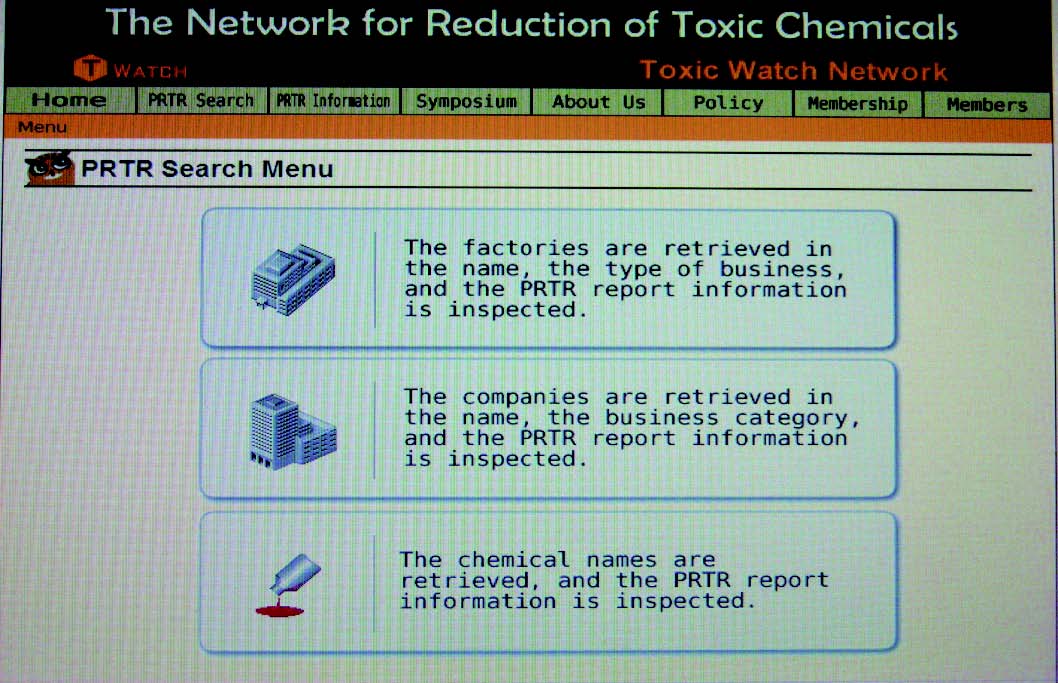| Using PRTR Data – T Watch and Organization for Research and Communication
on Environmental Risk of Chemicals (Eco-Chemi) (1) The Experience of T Watch In 2000, the author started discussions with several citizens’ organizations about the operation of a website where PRTR data disclosed by the government could be translated into comprehensive and meaningful information for citizens. In April 2002 the author and his colleagues established an independent organization called “Toxic Watch Network,” or “T Watch”. The national government often showed the attitude thatit government should make the people trust it, but it should not explain the reason,” and was not accountable to citizens. In such circumstances, T Watch was established in the hope that transmission of PRTR information would promote reduction of chemical use as well as chemical releases. The 2002 action policy of T Watch was approved by the inaugural meeting as follows: [1] Operating a website to transmit information which can be easily understood by citizens by processing and translating PRTR data disclosed by the national government, and by publishing an introductory PRTR guidebook for citizens; [2] Supporting NGOs and citizens to work regionally for reduction of chemical substance releases by using PRTR data; [3] Reviewing laws regarding toxic substances and advocating policy recommendations regarding comprehensive chemical management; [4] Networking with oversea NGOs to reduce toxic chemical substances globally; [5] Conducting research and studies regarding PRTR and chemical management and holding study meetings for citizens who are concerned about chemical substance related issues. As mentioned above, T Watch provides PRTR information for citizens. MOE and METI compile the data reported by BOs by prefectures and by industries for the chemical substances, and they calculate the Estimated Releases Outside Notification. Although the data reported by individual BOs are available on CD-ROM (it only became possible to download this from a website since 2009), it is not easy for citizens to access the information they want from the big spreadsheet format given by the government. Citizens would like to find out the environmental risks of the region where they live in an easier manner. In order to respond to such demands, it is necessary to understand the quantities of the various chemical substances released in municipal communities, to score the relative toxicity of these substances, and to calculate environmental risks by multiplying the quantities and the toxicity scores. As T Watch cannot do all the necessary work alone, it has been cooperating with the Organization for Research and Communication on Environmental Risk of Chemicals (nicknamed Eco-Chemi and which will be described later).
Table 1 shows contents of T Watch’s website (http://www.toxwatch.net/).
T Watch HP(http://www.toxwatch.net/)  Chart 7. A screen shot of the T Network website, accessed on Aug. 31, 2010. (2) The role of Organization for Research and Communication on Environmental Risk of Chemicals (Eco-Chemi) Eco-Chemi is an academic organization of scholars and business persons working on chemical substances and the environment. Eco-Chemi is mainly operated and managed by Professor Urano and Dr. Kameya’s laboratory at Yokohama National University. The laboratory offers information to the public, such as data on releases of PRTR substances, the use of pesticides by prefectures or by municipal communities, reference concentrations for air and water quality, and toxicity scores calculated based on information about human carcinogenicity, ecotoxicity, and sensitizing properties (17).
Table 2 shows the information available on Eco-Chemi’s website.
|
||||||||||||||||||||||
17) Website of Organization for Research and Communication on Environmental Risk of Chemicals. http://www.ecochemi.jp/ (Japanese only) |
||||||||||||||||||||||